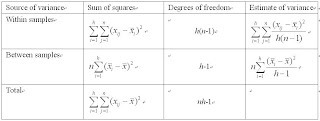(1) The within-samples estimate does not depend on the mean for any individual: had, for example, all of the ith sample’s measurements been increased by say, 5, this estimate of the variance would be unaltered. However, had the variability of the ith sample’s measurements increased, so would this estimate of that variance.
(2) The between-samples estimate does not depend on the ‘within-sample’ variability because it is calculated using the means of the samples. However, if one of these means is altered so is the estimate of variance. In particular, as the difference between the means increases so does the ‘between-class’ estimate of variance.
(3) To test whether the variances is significantly different from each other, we use the F-test.Two-way analysis of variance
 Example see http://www.mnstate.edu/wasson/ed602lesson13.htm
Example see http://www.mnstate.edu/wasson/ed602lesson13.htm
Example problem using One-way Analysis of Variance
Three groups of students, 5 in each group, were receiving therapy for severe test anxiety. Group 1 received 5 hours of therapy, group 2 - 10 hours and group 3 - 15 hours. At the end of therapy each subject completed an evaluation of test anxiety (the dependent variable in the study). Did the amount of therapy have an effect on the level of test anxiety?
The three groups of students received the following scores on the Test Anxiety Index (TAI) at the end of treatment.
| Group 1 - 5 hours | Group 2 - 10 hours | Group 3 - 15 hours |
|---|---|---|
| 48 | 55 | 51 |
| 50 | 52 | 52 |
| 53 | 53 | 50 |
| 52 | 55 | 53 |
| 50 | 53 | 50 |
The following table contains the quantities we need to calculate the means for the three groups, the sum of squares, and the degrees of freedom:
| Group 1 - 5 hours | Group 2 - 10 hours | Group 3 - 15 hours | |||
|---|---|---|---|---|---|
| X1 | (X1)2 | X2 | (X2)2 | X3 | (X3)2 |
| 48 | 2304 | 55 | 3025 | 51 | 2601 |
| 50 | 2500 | 52 | 2704 | 52 | 2704 |
| 53 | 2809 | 53 | 2809 | 50 | 2500 |
| 52 | 2704 | 55 | 3025 | 53 | 2809 |
| 50 | 2500 | 53 | 2809 | 50 | 2500 |
| ---------- | ---------- | ---------- | ---------- | ---------- | ---------- |
| 253 | 12817 | 268 | 14372 | 256 | 13114 |
The mean for group 1 is 253/5 = 50.6, the mean for group 2 is 268/5 = 53.6, and the mean for group 3 is 256/5 = 51.2
Is the differences between these three means significant? We can use analysis of variance to answer that question. Since we only have one independent variable, amount of therapy, we will use one-way analysis of variance. If we were concerned with the effect of two independent variables on the dependent variable, then we would use two-way analysis of variance.
First we will calculate SSB, the sum of squares between groups, where X1 is a score from Group 1, X2 is a score from Group 2, X3 is a score from Group 3, n1 is the number of subjects in group 1, n2 is the number of subjects in group 2, n3 is the number of subjects in group 3, XT is a score from any subject in the total group of subjects, and NT is the total number of subjects in all groups.



![]()
The degrees of freedom between groups is:
dfB = K - 1 = 3 - 1 = 2
Where K is the number of groups.
Next we calculate SSW, the sum of squares within groups.


![]()
![]()
The degrees of freedom within groups is:
dfW = NT - K = 15 - 3 = 12
Where NT is the total number of subjects.
Finally, we will calculate SST, the total sum of squares.


As a check SST = SSB + SSW
54.4 = 25.2 + 29.2
We can now calculate MSB, the mean square between groups, MSW, the mean square within groups, and F, the F ratio.



To test the significance of the F value we obtained, we need to compare it with the critical F value with an alpha level of .05, 2 degrees of freedom between groups (or degrees of freedom in the numerator of the F ratio), and 12 degrees of freedom within groups (or degrees of freedom in the denominator of the F ratio). We can look up the critical value of F in Appendix Table D of the text book (The 5 percent (Lightface Type) and 1 percent (Boldface Type) points for the Distribution of F), pages 319-326. Look in the table under column 2 (2 degrees of freedom for the numerator) and row 12 (12 degrees of freedom for the denominator) and read the non-boldfaced entry (for .05 level) of 3.88 - this is the critical value for F.
One way of indicating this critical value of F at the .05 level, with 2 degrees of freedom between groups and 12 degrees of freedom within groups is
F.05(2,12) = 3.88
When using analysis of variance, it is a common practice to present the results of the analysis in an analysis of variance table. This table which shows the source of variation, the sum of squares, the degrees of freedom, the mean squares, and the probability is sometimes presented in a research article. The analysis of variance table for our problem would appear as follows:
| Source of Variation | Sum of Squares | Degrees of Freedom | Mean Square | F Ratio | p |
|---|---|---|---|---|---|
| Between Groups | 25.20 | 2 | 12.60 | 5.178 | <.05 |
| Within Groups | 29.20 | 12 | 2.43 | ||
| Total | 54.40 | 14 |

No comments:
Post a Comment